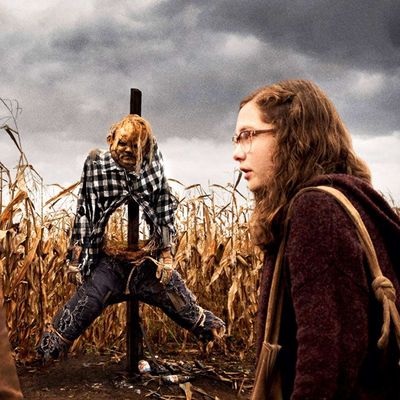
There is absolutely nothing original in Scary Stories to Tell in the Dark, which just goes to show that you don’t need originality to be effective. That was also true of Alvin Schwartz’s classic children’s horror-story collections, published in the 1980s, which themselves drew from grisly folk legends and campfire tales. Schwartz’s work aroused some controversy back in the day; many adults felt the stories were too disturbing and violent for their intended audience, which of course made the books even more popular. The film, directed by André Øvredal and produced by Guillermo del Toro, has a bit of that same bait-and-switch sneakiness.
It starts off as a quaint, atmospheric small-town fright flick before plunging headlong into a full-on, grotesque shriek-fest with severed heads, scarecrows that fight back, demons that are ripped into pieces and then reassemble themselves, and asylums filled with giant bulbous smiling creatures that slowly corner you and consume you. The debates over the Scary Stories books may seem antiquated nowadays — with young adult literature having worked grisly, murderous dystopias for decades — but one still gets a pleasant, can-they-do-that chill at seeing unnerving, old-school horror in such a seemingly wholesome setting.
But that’s sort of the idea, of course, not just conceptually but also politically. The movie is set in the hamlet of Mill Valley, Pennsylvania, on the eve of the 1968 presidential election — one of the first things we see is a row of defaced Nixon posters on which the “X” has been replaced with a swastika — and reports about the Vietnam War constantly drone on TV sets in the background. The protagonists are a trio of high-school outcasts — horror buff and aspiring writer, Stella (Zoe Margaret Colletti); shy, well-to-do Augie (Gabriel Rush); and scrappy, dorky Chuck (Austin Zajur) — who hook up with young drifter Ramon Morales (Michael Garza) while trying to evade a group of belligerent jocks. By the time they meet (at a drive-in theater showing Night of the Living Dead, naturally), Ramon has already been harassed by the local racist cops. Later, the jocks will scrawl “wetback” all over his car.
Still on the run, the youths wind up in an abandoned house that once belonged to a family of local industrialists. Legend has it that the daughter of the family, a mysterious shut-in named Sarah Bellows, was a child murderer who also liked telling scary stories. In fact, anyone who heard one of her yarns promptly vanished. Stella soon finds Sarah’s half-empty book of stories — and new tales, featuring our heroes as characters, promptly start mysteriously appearing on the page, scrawled in blood. The stories themselves are turbo-loaded versions of Schwartz’s beloved ones. So, the severed head muttering “Me-tie dough-ty walker” still drops out of the chimney, but it’s accompanied by a lot more. Harold the scarecrow no longer skins his prey, opting instead for something less graphic and more disturbing. The notorious “Red Spot” also makes an appearance, but this time it’s accompanied by a dark cloud of menace. These incidents are no longer disconnected, grisly cosmic jokes, but evidence of a broader, growing evil.
Trying to find a way to undo these horrors, the kids decide to investigate what happened to Sarah Bellows and her family so many years ago. It almost goes without saying that, amid the usual scary-movie shenanigans, this cute, all-American small town will turn out to have some dark secrets lying beneath its surface. Political overtones are nothing new to the genre, but what Scary Stories does so well is in psychologically connecting all these elements — the election, the war, and the racism — with the sense that horror and murder are self-generating phenomena in a world without justice. This also connects the film to our present-day reality: Without giving too much away, a climactic set piece that seems to take place in two different timelines, each feeding the other, suggests that the crimes of the past reverberate and reoccur throughout the ages. It’s like Goosebumps meets Chinatown.
That may also be the picture’s one big shortcoming, however. Øvredal and his team do such a good job incorporating these sociopolitical overtones into the bread-and-butter genre mechanics of their overall plot that you may find yourself wanting more — more, at least, than the generic finale and the obligatory setup for a sequel that we do get. Is it highly odd or highly appropriate that a movie all about the poisonous power of unresolved stories would turn out to be a little unresolved itself?


